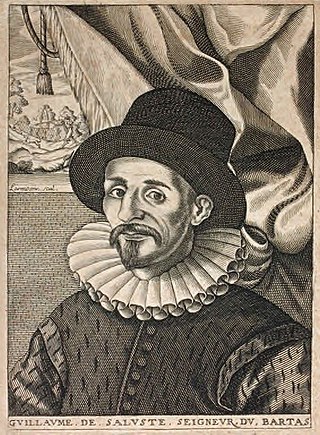| |||
|---|---|---|---|
| +... |
Nationality words link to articles with information on the nation's poetry or literature (for instance, Irish or France).

Guillaume de Salluste du Bartas was a Gascon Huguenot courtier and poet. Trained as a doctor of law, he served in the court of Henri of Navarre for most of his career. Du Bartas was celebrated across sixteenth- and seventeenth-century Europe for his divine poetry, particularly L'Uranie (1574), Judit (1574), La Sepmaine; ou, Creation du monde (1578), and La Seconde Semaine (1584-1603).
Nationality words link to articles with information on the nation's poetry or literature.
Nationality words link to articles with information on the nation's poetry or literature.
Nationality words link to articles with information on the nation's poetry or literature.
Nationality words link to articles with information on the nation's poetry or literature.
Nationality words link to articles with information on the nation's poetry or literature.
Nationality words link to articles with information on the nation's poetry or literature.
Nationality words link to articles with information on the nation's poetry or literature.
Nationality words link to articles with information on the nation's poetry or literature.
Nationality words link to articles with information on the nation's poetry or literature.
Nationality words link to articles with information on the nation's poetry or literature.
Nationality words link to articles with information on the nation's poetry or literature.
Nationality words link to articles with information on the nation's poetry or literature.
Nationality words link to articles with information on the nation's poetry or literature.
Nationality words link to articles with information on the nation's poetry or literature.
Nationality words link to articles with information on the nation's poetry or literature.
Nationality words link to articles with information on the nation's poetry or literature.
Nationality words link to articles with information on the nation's poetry or literature.
Nationality words link to articles with information on the nation's poetry or literature.
The Model of Poesy (1599), by William Scott, is a Renaissance-era, English literary treatise about the art of poetry, which presents a theoretical description of what is poetry, and practical guidelines about how to write well. Proceeding from An Apology for Poetry (1595), by Philip Sidney, The Model of Poesy develops Scott's poetics in the classical and continental traditions, using examples from Geoffrey Chaucer and Edmund Spenser, William Shakespeare and quotations from Scott's partial, English translation of the French La Sepmaine (1578), by Guillaume de Salluste du Bartas.